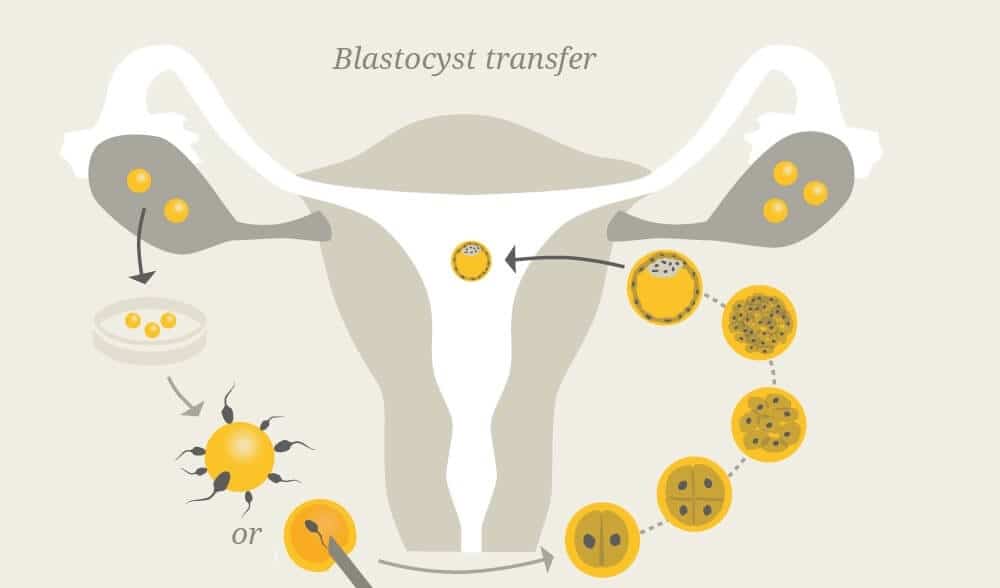Reasons to have Blastocyst Transfer – Placing the embryo at the blastocyst stage makes things more straightforward and fruitful for implantation. Blastocyst transfer of an embryo is performed during the In Vitro Fertilization procedure. And In Vitro Fertilization is performed when the couple is unable to conceive natural pregnancy. Blastocyst switch or transfer is an embryo transfer that includes transferring one or more embryos, which might be at a totally superior stage of development (matured); the so-referred procedure referred to as blastocyst transfer. The IVF specialists carry out blastocyst transfer on the fifth or sixth day after the egg collection step. After the expert has taken out the eggs from an ovary (follicular aspiration), they are fertilized inside the laboratory. Fertilization is accomplished both by regular in vitro fertilization (IVF) and by using Intracytoplasmic sperm injection (ICSI). Right away after fertilization, the fertilized egg begins to divide and becomes an embryo.
The stages of development are as follows
- the first stage of a fertilized egg – pronuclear phase
- on the second day – two to four-cell stage
- On the fourth day – Morula stage
- Fifth day – Blastocyst Stage
During the conventional IVF treatment, the fertility doctor generally places one or extra embryos within the woman’s uterus two to a few days after the egg collection process. This method is known as embryo transfer. However, in IVF with the blastocyst stage, the embryos are developed in an incubator up to the fifth day, i.e., the blastocyst phase. The technology has been improved and it is getting better day by day; we are lucky to avail of all these advanced technologies in the medical domain. The outcome of implantation becomes high if the embryo has placed on the fifth day of follicular aspiration.
In short, if the fertility specialist transfers developed embryos (fifth day of follicular aspiration) into the woman’s uterus, then this procedure is called blastocyst transfer.
Embryo transfer is the last part of an IVF treatment. Numerous couples who are longing to have their own child select the process of IVF with the blastocyst transfer process. Blastocyst transfer is exceptionally regular in IVF treatment. The chances of attaining pregnancy by blastocyst transfer are very high compared to conventional IVF treatment.
Here are four reasons why it might be desirable over have a blastocyst transfer:
- The blastocyst is the last phase of preimplantation improvement: That implies that they have accomplished every one of their points of reference. At around day, three incipient organisms switch all alone qualities; thus, this is an essential time of their advancement. Numerous incipient organisms quit creating around this time. At the blastocyst stage, we can be quite sure that the incipient organisms (embryos) can grow further. Exchanging incipient organisms on day three implies that we can’t make certain which ones will achieve blastocyst stage.
- Blastocyst Transfer: It offers the chance to exchange stand out fetuses instead of numerous. We don’t have to ‘fence your wagers’ trusting that no less than one embryo will achieve the blastocyst stage. By lessening the number of fetuses exchanged, the occurrence of different pregnancy is decreased.
- A blastocyst usually is to be found in the womb after in vivo origination: They go down the Fallopian Tube separating and achieve the womb at a phase prepared to embed. In IVF, day three developing lives are moved into the uterus where they hold up and grow until they are ready to integrate. It is impractical to move them into the fallopian tubes where they would be at this stage. It might be that the earth of the womb is not an ideal spot for early incipient organisms. Be that as it may, the move of blastocyst Transfer into the womb implies that they are put into their most common habitat.
- Preimplantation hereditary screening: (PGS) is turning out to be more regular in IVF. These procedures check the developing life for variations from the norm so that exclusive hereditarily typical fetuses are chosen for exchange. Amid PGS, cells must be removed from the developing organism to test for irregularities. These cells are an agent test of the developing life. In any case, in early developing lives, just 1 or 2 cells can be extricated without bringing on the fetus an excessive amount of harm.
However, because of the more significant number of cells of a blastocyst (around 100), more cells can be utilized to check for irregularities giving a more precise result with less effect on the developing organism. So if the goal is to utilize PGS, then a blastocyst transfer may offer a superior outcome.
The Bottom Line
Compared to the standard IVF result, the success rate of IVF with blastocyst transfer is high. Women, who are up to the age of 30, the possibility of being pregnant is between 57-67%, and for women aged 30-35, their chance of achieving pregnancy is approx. 50-55%. If the embryos are found to be healthy in quality on the fifth day of follicular aspiration, then there would be a decent likelihood of being pregnant. Women with low egg count and poor quality may indeed get an advantage if they choose conventional IVF where the embryo gets transferred on the second day of fertilization.
It is impractical for everybody to have developing lives which achieve the blastocyst transfer in society. It might be that a few embryos which stop in vitro may have grown further in vivo. Surely, before the research facility was fit for developing fetuses until the blastocyst organizes, all incipient organism exchanges happened at day2/3. The capacity to build up the incipient organisms further can be considered as another system that may expand the shot of accomplishment for a few couples.
We Care IVF Surrogacy is one of the leading healthcare platforms which have been ranked as the number one fertility service providing agency. Providing all the advanced techniques at an affordable price, the team of We Care also gives a high success rate. Senior IVF specialist and the fertility team have years of experience solving infertility issues. We welcome all those couples, who are getting trouble achieving pregnancy by suggesting them a suitable fertility treatment and performing the best procedure to attain pregnancy.




